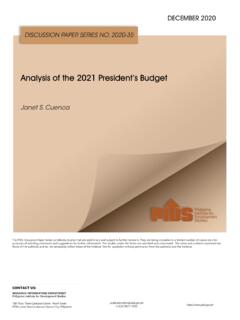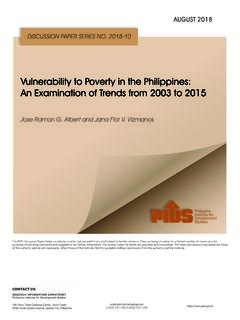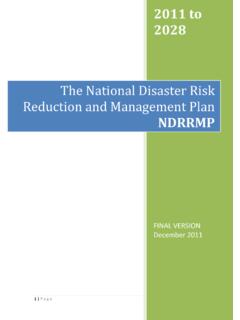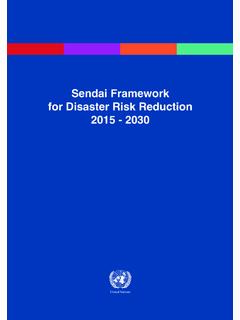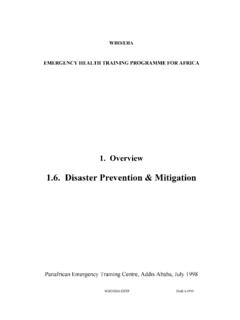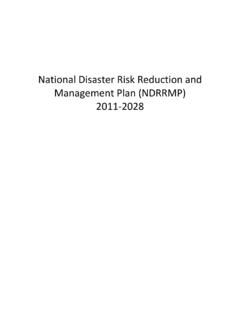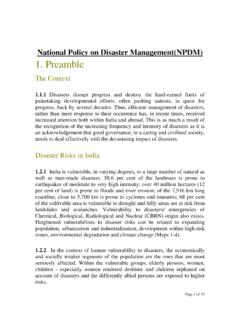Transcription of Disaster Preparedness and Local Governance in the …
1 DISCUSSION PAPER SERIES NO. 2018-52 DECEMBER 2018 Disaster Preparedness and Local Governance in the PhilippinesThe PIDS Discussion Paper Series constitutes studies that are preliminary and subject to further revisions. They are being circulated in a limited number of copies only for purposes of soliciting comments and suggestions for further refinements. The studies under the Series are unedited and unreviewed. The views and opinions expressed are those of the author(s) and do not necessarily reflect those of the Institute. Not for quotation without permission from the author(s) and the US:RESEARCH INFORMATION DEPARTMENTP hilippine Institute for Development Studies18th Floor, Three Cyberpod Centris - North Tower EDSA corner Quezon Avenue, Quezon City, 372-1291/(+632) 372-1292 N. Domingo and Arvie Joy A. ManejarDisaster Preparedness and Local Governance in the Philippines Sonny N.
2 Domingo Arvie Joy A. Manejar PHILIPPINE INSTITUTE FOR DEVELOPMENT STUDIES December 2018 Abstract The high level of casualties, population displacements and economic costs from recent Disaster events still point to necessary augmentations in Disaster Preparedness . Policy has to be revisited, institutional arrangements have to be reviewed and resource mobilization issues have to be addressed. RA10121, albeit strong on its own, has to be enhanced and supported by functional department policy to be aptly cascaded. Policy and planning alignments also have to be enhanced both from the national to subnational levels and horizontally within Local government institutions and national government agencies. Keywords: Disaster Preparedness , Local Governance , Disaster risk reduction and management Table of Contents 1. Introduction / Background of the Study 1 Rationale 1 Objectives 1 2.
3 Methodology 2 Background 2 Approach of the study 2 Research design and conceptual framework 5 Evaluation Methodology 7 3. Related Literature 11 Timeline of policies 11 Role of LGUs 12 DRRM in NDRRMP and climate change acts, prospects and moving forward 16 4. Results 16 Fiscal Analysis 16 Case Studies 27 5. References 43 List of Tables Table 1. Key components of process evaluation (Linnan & Steckler 2002) 6 Table 2. Guide questions and key components in process evaluation framework 7 Table 3. Data collection method and tools used 9 List of Figures Figure 1. Critical design under the narrative approach (Edmonds and Kennedy 2013) 4 Figure 2. Critical design adapted to the study 4 Figure 3. Logic model (Logic Model Workbook nd) 6 Figure 4. Process evaluation framework 7 Figure 5. Flowchart of conceptual framework 11 Figure 6. Trend and composition of Calamity Response Fund 15 Figure 7.
4 Trend and shares of various government agencies in the QRF from 2009-2013 (COA, nd) 15 Figure 8. Local mitigation fund from 2015-2018 23 Figure 9. Local quick response funds from 2015-2018 24 Figure 10. NDRRMF downloaded to allocation and utilization from 2015-2018 (FDPP) 24 Figure 11. Local 20 percent EDF allocation and utilization (FDPP) 25 Figure 12. Allocation and utilization of funds from other LGUs and Local sources from 2015-2018 (FDPP) 25 Figure 13. Allocation and utilization of funds from international development organizations (FDPP) 26 Figure 14. All fund sources for Disaster from 2015-2018 (FDPP) 26 Figure 15. Allocation and utilization of the mitigation fund in Marikina City from 2015-2018 27 Figure 16. Allocation and utilization of the quick response fund in Marikina City from 2015-2018 28 Figure 17. Allocation and utilization of LDRRMF in Marikina City from 2015-2018 28 Figure 18.
5 Allocation and utilization of mitigation fund in Pasig City from 2015-2018 30 Figure 19. Allocation and utilization of quick response fund in Pasig City from 2015-2018 30 Figure 20. Allocation and utilization of LDRRMF in Pasig City from 2015-2018 31 Figure 21. Utilization of available DRRM funds in Abuyog from 2012-2017 32 Figure 22. Utilization of funds per expenditure type in Abuyog from 2012-2017 33 Figure 23. Utilization of available funds in Abuyog from 2016-2017 36 Figure 24. Utilization of funds per expenditure type in Abuyog from 2012-2017 37 Disaster Preparedness and Local Governance in the Philippines Sonny N. Domingo and Arvie Joy A. Manejar1 1. Introduction / Background of the Study Rationale The Philippines is prone to natural disasters as it lies along both the typhoon belt and the Pacific ring of fire. Just within the current decade, thousands of lives had been lost, millions of people had been displaced and hundreds of billions worth of damages had been incurred due to Disaster events.
6 The year 2011 saw 18 floods and landslides, 12 typhoons including the devastating typhoon Sendong, two volcanic eruptions and one earthquake causing 1,439 casualties and a total of million affected victims (Guha-Sapir et al. 2011). 2012 hosted typhoon Bopha which devastated provinces in Mindanao killing more than a thousand people and damaging billions worth of properties, livelihood and infrastructure. In 2013, super typhoon Haiyan s ( Local name: Yolanda, category 5) wind speed of more than 300 kph caused four-meter storm surges across nine regions and 44 provinces, resulting to a death toll of 8,000 people, million destroyed houses, and PHP 200 billion of damaged properties (GFDRR, 2015; Campanero and Egargo 2017). More recent typhoons like Vinta and Urduja which came before the end of 2017 also left the Philippines with more than three hundred dead and missing and billions worth of damages.
7 A similar Disaster situation was witnessed before the end of 2018 where 126 people died and 4 billion worth of agricultural crops and infrastructure were damaged due to the floods and landslides brought about by tropical depression Usman. The above highlight the need to augment Disaster Preparedness , particularly in more vulnerable developing countries like the Philippines where compounding elements magnify Disaster impacts. Environmental degradation, urbanization, marginalization, high population density, weak bureaucratic institutions, and lack of preparation for disasters combine with other man-induced and natural risks. The combined risks from these factors are experienced more by the poorer communities within the developing states (Kusumasari et al. 2010). One way to mitigate the magnitude of effects of disasters is preparing for them.
8 There have been international agreements and frameworks for perusal of these developing countries, and these are rationally integrated in the countries national policies. However, the critical question is whether these national policies are being grounded among Local communities and which mechanisms are used to implement such. Objectives Recognizing the need to evaluate Disaster Preparedness and Local Governance , the study generally assessed Disaster risk Preparedness among selected Local government units and look into issues pertaining to Local Governance and Disaster risk management. Specifically, the study sought to conduct the following: a. evaluation of the national and Local government policy on Disaster risk Preparedness ; 1 Senior Research Fellow and Research Analyst, respectively, Philippine Institute for Development Studies b.
9 Examination of the state of Preparedness activities and Governance concerns in select; localities, and; c. provision of recommendations for possible policy augmentations and implementation arrangements. 2. Methodology Background In a Disaster -prone country like the Philippines, much is expected from the Local governments which are considered to be the core of a community. A Local government unit (LGU) remains integral across phases before, during, and after disasters as mandated by the Local Government Code of 1991. Solway (2004) outlined the basic roles of the Local government in facilitating the community during a Disaster . The LGU must be able to (1) assess the vulnerabilities of the area and its constituents, (2) instill basic knowledge of natural disasters and the possible impacts, (3) conduct an information and education campaign (IEC) on Disaster mitigation, (4) coordinate with officials in charge of planning, construction, health, and welfare, (5) conduct first-aid trainings, (6) partner with educational institutions to broaden awareness and support existing knowledge, and (7) build evacuation centers and determine safe locations for those affected.
10 However, there have been instances where LGUs were sidelined in the process due to the overlapping duties and responsibilities among involved institutions, and unclear command responsibility, observed most particularly during super Typhoon Haiyan. There were also concerns pertaining the utilization of the Local Calamity Fund which will be tackled later on in the discussion. Thus, there was a need to revisit the DRRM policies, particularly the implementation processes, and determine whether the policies have an impact and reach on Local communities. In line with this, the study conducted a process evaluation which focused on the evaluation of policy implementation within LGUs and looked into various indicators of Preparedness and resiliency as an outcome of the policy. Approach of the study The research design of this study fell under one of the qualitative and non-experimental approaches.


